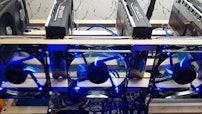Monero (XMR) Cryptocurrency Explained – Guide for 2025
- Where to Buy Monero – Top 4 Places for 2025
- What Is Monero (XMR)?
- How to Buy Monero (XMR) in 2025
- Where to Buy Monero in 2025
- The Purpose of Monero (XMR)
empty
empty
empty
- Monero vs Bitcoin and Other Cryptocurrencies
empty
empty
- How To Mine Monero in 2025
- Is Monero a Good Investment in 2025?
empty
empty
- Monero Price Prediction 2030
- Frequently Asked Questions
- Final Thoughts
Where to Buy Monero – Top 4 Places for 2025
What Is Monero (XMR)?
Monero (XMR) is a type of cryptocurrency like Bitcoin (BTC) and Ethereum (ETH). It is a decentralized currency with a value that is not based on a physical entity such as a government or gold, unlike fiat (traditional) currency.
Monero originally launched as ‘Bitmonero’ in April 2014 and came from a hard fork in the Bytecoin cryptocurrency.
Bytecoin was one of the first ‘privacy coins’ in the world, developed to offer complete anonymity for both transactions and users. This private element was missing from other altcoins like Bitcoin.
The blockchain for Bytecoin was developed using CryptoNight, which uses several keys in a single transaction, making it more difficult to find out who sent what coins where. CryptoNight is the main structure of most privacy-based cryptocurrencies available today.
When Bytecoin was launched, there was some controversy amongst the developers due to the fact that over 80% of the bytecoin was issued during the launch. This created a hard fork and the introduction of Bitmonero as an alternative.
After rebranding to Monero (‘money’ or ‘coin’ in Esperanto), Monero became the best-known private coin available and is credited with the rise of other private altcoins which have a combined value of almost $2 billion.
Through anonymization protocols and advanced cryptographic functions, the data of all Monero transactions are kept completely private and untraceable.
Alongside the usual mission of cryptocurrency (decentralization and security), privacy is the main feature of Monero.
How to Buy Monero (XMR) in 2025
Step 1. Research and Choose a Reliable Exchange
Start by researching and selecting a reputable cryptocurrency exchange that supports Monero trading. Some popular exchanges include Binance, Kraken and Bitfinex.
Step 2. Create an Account
Sign up for an account on the chosen exchange. You'll need to provide your email address, create a password, and complete any verification requirements.
Step 3. Verify Your Identity
Most exchanges require identity verification for security and regulatory compliance. Prepare your identification documents such as a driver's license or passport, as well as proof of address.
Step 4. Deposit Funds
Deposit funds into your exchange account. Depending on the exchange, you can use various methods such as bank transfers, credit/debit cards and even PayPal.
Step 5. Search and Buy Monero (XMR)
After your funds are deposited, use the exchange's search or trading function to find Monero (XMR) pairs. Place a buy order for the amount of Monero you want to purchase.
Step 6. Store in a Secure Wallet
While it's possible to leave your Monero on the exchange, for added security, it's recommended to buy XMR and transfer your purchased XMR to a secure Monero wallet.
Step 7. Buy Monero UK
If you're in the UK, make sure the exchange you choose supports customers from your region. Some exchanges might offer GBP trading pairs for Monero.
Step 8. Buy Monero Anonymously
To buy Monero anonymously, consider using peer-to-peer (P2P) platforms like LocalMonero or Bisq, where you can directly trade with individuals.
Keep in mind that using P2P platforms might involve higher fees and more caution.
Step 9. Buy Monero with Credit Card or PayPal
Look for exchanges that allow you to buy Monero with PayPal or credit cards.
Step 10. Best Monero Wallet
When it comes to storing Monero, consider using official Monero wallets like the GUI Wallet or CLI Wallet. Hardware wallets like Ledger and Trezor also support Monero for added security.
Where to Buy Monero in 2025
Monero can be purchased on various cryptocurrency exchanges such as Binance, Kraken, Bittrex and Bitfinex.
These exchanges allow you to trade popular cryptocurrencies like Bitcoin or Ethereum for Monero.
Additionally, you can also buy Monero directly on platforms like LocalMonero or through peer-to-peer trading. It's important to do thorough research and choose a reputable and secure exchange to ensure the safety of your transactions and funds.
1. Binance
Pros
- Wide availability
- Liquidity
- Advanced trading features
Cons
- Regulatory concerns
- Withdrawal fees
- Third-party risk
Binance is one of the largest and most well-known cryptocurrency exchanges in the world. It offers a variety of cryptocurrencies, including Monero (XMR), for trading.
As Binance is a popular exchange, this often translates to high liquidity. This means that there are likely to be ample buyers and sellers for Monero, potentially leading to smoother and faster transactions.
2. Kraken
Pros
- Low minimum deposit
- Available on web and mobile app
- Useful educational resources for beginners
- Wide range of cryptocurrencies
Cons
- Fees can be high without Kraken Pro
- Poorly rated customer service
- Funding an account can be slow
Kraken is a reputable cryptocurrency exchange known for its security features and wide range of supported cryptocurrencies. It offers various trading pairs, including Monero.
Kraken's platform is designed to be user-friendly, making it accessible to both beginners and experienced traders. The interface is intuitive and offers a range of features for different trading needs.
3. Bittrex
Pros
- Variety of cryptocurrencies
- Security
- Liquidity
Cons
- Account verification
- Withdrawal fees
- Customer support
Bittrex is a cryptocurrency exchange that offers a variety of cryptocurrencies for trading. It's known for its security measures and user-friendly interface.
To buy Monero on Bittrex, you generally need to create an account on the platform, deposit funds into your account, and then use those funds to purchase Monero through a trading pair like XMR/USD or XMR/BTC.
4. Bitfinex
Pros
- Liquidity
- Advanced trading features
- Security
Cons
- Regulatory concerns
- Withdrawal fees
- User interface complexity
Bitfinex is a cryptocurrency exchange known for its advanced trading features and liquidity. It's one of the larger exchanges in terms of trading volume.
It offers a wide range of cryptocurrencies for trading, including Monero (XMR). This allows you to easily buy and trade Monero alongside other digital assets.
Bitfinex has implemented security measures to protect users' funds and data. This includes features like two-factor authentication (2FA) and cold storage of a significant portion of their users' funds.
The Purpose of Monero (XMR)
The mission of Monero (XMR) is to address the privacy concerns that are rife with other popular cryptocurrencies.
Despite some users believing that their transactions with decentralized currencies are anonymous, the public ledger of the blockchain for BTC and other cryptocurrencies makes it possible to trace not only the sender and receiver of the currency but also the amount sent.
Monero’s privacy is achieved by a combination of three protocols:
Monero Ring Signatures
When a transaction is created using Monero, the digital signature of the sender is combined with several other signatures – there are currently 10 signatures in every transaction group. This makes it almost impossible to tell who is sending the currency.
This measure, alongside other Monero protocols, updates every six months to be an ever-evolving concept, altering the number of signatures and addresses used to mask transactions.
Monero Stealth Addresses
The idea of a stealth address is that each transaction is created using a one-time account. This makes it practically impossible to trace a transaction to a user because the address is gone once the transaction is completed.
Monero RingCT
Developed in 2017, RingCT (Ring Confidential Transactions) hides the amount of monero in the transaction by including a number of other inputs and outputs with it, in a similar way to the ring signatures.
Monero vs Bitcoin and Other Cryptocurrencies
How Is Monero Similar to Non-Private Cryptocurrencies?
Monero and Bitcoin are both based on a blockchain and are mined through a network of computers (known as nodes) that verify transactions.
Both are decentralized digital currencies that can be created, bought and sold through online exchanges. They are protected through the blockchain, verified using nodes, and transactions take place using keys and passwords for privacy.
The basic principles of cryptocurrencies make them all similar in this way. That is why they often follow the same bearish and bullish patterns in terms of price.
How Is Monero Different?
When BTC and other digital currencies were first pioneered, one of the biggest selling points for early adopters was the idea of a completely anonymous currency exchange. However, Bitcoin should be considered more like a pseudonymous transaction because every exchange is recorded on the blockchain in a public ledger – each BTC can be tracked and traced through users.
Monero addresses this, increasing its popularity with users who are looking to protect their assets from others (including governments and institutions).
The fungibility of Monero is another aspect that sets it apart from other digital currencies. Fungible assets can be exchanged for other assets of the same type, including goods, commodities, fiat currency and cash. However, the difference between Monero, fiat currency and most altcoins is that it cannot be traced through transactions.
Cash is often thought to be an untraceable way of completing transactions, but even this method of payment can be tracked thanks to serial numbers.
Bitcoin can be traced through the blockchain. If it is flagged as being used for an illegal purchase, it can no longer be exchanged. From an asset-holding point of view, if you have received BTC that has been used in a fraudulent or illegal transaction, it becomes unusable for further transactions, making it effectively worthless.
How To Mine Monero in 2025
Cryptocurrency is created through a process called mining. This is a system that has been created to ‘reward’ nodes that verify altcoin transactions with an amount of cryptocoin.
Step 1. Hardware Selection
Monero mining can be done using both CPUs and GPUs, but CPUs are generally more accessible for most users. You can also use specialized mining hardware (ASICs), but Monero's algorithm, RandomX, is designed to be resistant to ASIC mining.
Step 2. Choose a Mining Software
Select a mining software that's compatible with Monero mining. Popular options include XMRig and XMR-Stak.
Step 3. Set Up a Monero Wallet
You'll need a Monero wallet to receive your mined coins. You can choose from various wallet options, such as the official Monero GUI wallet, CLI wallet, or third-party wallets.
Step 4. Join a Mining Pool (Optional)
Monero mining can be competitive, so many miners join mining pools to combine their computational power and increase their chances of receiving rewards more consistently. Some popular Monero mining pools include supportxmr.com and monerohash.com.
Step 5. Download and Configure Mining Software
Download your chosen mining software and follow the instructions to configure it. You'll need to provide the mining pool's address, your wallet address, and other settings.
Step 6. Start Mining
Run the mining software, and it will start using your computer's computational power to mine Monero. Monitor the software to ensure it's working correctly and generating hashes.
Step 7. Monitor Performance and Payouts
Keep an eye on your mining software's performance, temperature, and hashrate. Most mining pools have a dashboard where you can track your earnings. Payouts are typically based on the amount of computational power you contribute.
Step 8. Understand Power Costs
Mining requires electricity, and it's essential to consider your electricity costs when calculating potential profits. High electricity costs might offset your mining rewards.
Step 9. Stay Updated
The cryptocurrency landscape evolves, and mining algorithms or software might change. Stay informed about any updates or changes that could impact your mining operations.

Monero miners use their computing power to ‘solve’ complicated problems and create new blocks of data to add to the blockchain. The node that completes the problem will be rewarded with a specific amount of that coin once it has been verified by other Monero nodes in the network.
Mining takes a lot of computing power, and in larger blockchains like Bitcoin, this is now only considered to be profitable with a huge, expensive setup using Application Specific Integrated Circuits (ASICs) to complete transactions. This means that, for most cryptocurrencies, it is no longer financially viable to mine, as most of the rewards will go to ‘mining farms’.
With Monero, the CryptoNight algorithm does not allow for ASIC mining. Therefore, in most cases, it is possible to get rewards through using a CPU or GPU as your Monero mining rig (and therefore minimal setup costs).
CPU mining uses a computer’s central processing unit and special software. A good computer will offer a fast hash rate (number of attempts to solve the problem per second) without much cost. Updating a CPU can cost anywhere from $50 to $150.
The faster – and more rewarding – option is GPU mining. Purchasing a graphics processing unit (GPU) can cost up to $500, but in turn, the hash rates are often considerably higher, increasing the Monero mining profitability.
All that is needed after the relevant hardware is simple Monero mining software, which is generally free to download.
You can mine Monero yourself (solo mining). This allows you to retain all the rewards you earn but can take a lot of computing power (as well as the ongoing costs of increased electricity usage).
Another option to reliably receive mined coins is to join a mining pool. These linked Monero nodes work in tandem to solve problems and are more likely to be successful in creating new blocks thanks to the combined computational power.
Joining a Monero mining pool usually involves paying a fee, which tends to be a percentage of the rewards generated, shared between users depending on the amount of power allocated by each node.
Mining Monero is much more accessible than many other cryptocurrencies. However, whether it will be profitable for you depends on the balance between possible rewards and the costs of the operation, from the initial purchase of hardware to ongoing electricity costs.
Is Monero a Good Investment in 2025?
Should You Invest in Cryptocurrencies Generally?
Cryptocurrency has been around for more than ten years, but traditional investors and financial institutions are not keen on it due to the volatility and unregulated nature of decentralized exchanges.
Investing in cryptocurrency in general needs careful consideration because it is decentralized and mostly unregulated.
Digital currency is becoming more common and can even be used to make purchases in the ‘real world’ with some well-known physical stores accepting Bitcoin and other digital currency in the same way as fiat currency.
There are trading courses available to help you learn how to trade in digital currencies.
The other consideration with cryptocurrencies is that, although they are meant to be ‘borderless’, some governments have banned the purchase of digital coins in their countries.
Despite these drawbacks, many Bitcoin and altcoin adopters believe that digital currency is the future of finance. You may decide that, as long as you can afford to lose the money you invest (so don’t bet your house on it), cryptocurrency may be a fun, exciting way to invest.
Should You Invest in Monero?
Investing in Monero specifically is not as simple as other cryptocurrencies as it is less available in popular exchanges.
Also, the privacy that makes it popular with users means that Monero is not popular with many governments and institutions as they cannot trace transactions.
Monero and other privacy coins are typically considered the ‘currency for criminals’ because they have been a mainstay of transactions on the ‘dark web’.
Dark-web marketplaces such as Alphabay might accept Monero for transactions, but there is not much uptake from merchants on the lighter side of the internet. This may be a major reason why it makes regulators so uncomfortable.
Monero is gaining in value and popularity for several reasons. While its value tracks other cryptocurrencies like Bitcoin in terms of market direction, there is a surge in popularity for investors whenever regulators impose new bans on digital currency usage.
As more and more regulations come into force for cryptocurrency, Monero and other privacy coins are more inviting for some people due to their inbuilt security and privacy from governments and agencies.
It is worth noting that, despite the public perception of privacy coins being used for illicit activities, as a user or holder you will not know if your monero has previously been used in this way. This might pose an ethical dilemma for some investors, but if you wouldn’t throw away cash that had been used in a crime, this is less likely to be a problem for you.
Another consideration is the inherent difficulty for merchant services needed to pay for other assets and commodities using Monero. The anonymity becomes a roadblock to using the currency for other purchases, although there is software in development to make this less of a problem.
The suggested illicit usage of Monero on the dark web should be considered too, as perception could slow more widespread adoption and mean that there is unlikely to be a ‘Tesla accepts Bitcoin’ moment for Monero.
Monero Price Prediction 2030
Since its launch in 2014, Monero began to gain attention and reached over $10 in 2017. In just 6 months, Monero's price surged to arund $140, climbing to and all-time high of $470 by January 2018.
The Monero price now is estimated $233.64 and is predicted to continue rising.
The monero price prediction will see a steady growth over the next seven years, rising from $389.41 in 2024 to a monero price prediction 2030 of over $1,300.
The value of XMR to USD is currently 1 XMR is worth $154.80. The Monero to USD value continues to grow.
Frequently Asked Questions
A Monero remote node refers to a computer or server running the Monero software that allows users to connect to the Monero blockchain without having to download and synchronize the entire blockchain on their local device.
By connecting to a remote node, users can access the Monero network, view transaction history, and send or receive Monero transactions without the need for extensive computational resources or storage space.
Remote nodes provide a convenient way for users to interact with the Monero blockchain while minimizing the requirements on their own hardware.
To buy XMR (Monero), you can follow these steps:
- Choose a reputable cryptocurrency exchange that supports Monero, such as Binance, Kraken, or Bitfinex.
- Create an account on the chosen exchange and complete the necessary verification process.
- Deposit funds into your account using a supported payment method, such as a bank transfer or credit/debit card.
- Locate the XMR trading pair (e.g., XMR/USD or XMR/BTC) on the exchange platform.
- Enter the desired amount of XMR you want to purchase and review the order details.
- Execute the trade and wait for the transaction to be processed.
- Once the transaction is complete, the purchased XMR will be available in your exchange account.
To convert Monero to USD, you need to follow these steps: Find a reputable cryptocurrency exchange that supports XMR and USD trading pairs. Create an account on the exchange and complete any required verification.
Deposit your XMR into the exchange wallet. Look for the XMR/USD trading pair. Enter the amount of XMR you want to sell and review the details. Execute the trade.
Once the transaction is complete, you can withdraw the converted USD funds to your linked bank account or preferred payment method.
A Monero mining calculator is a tool that estimates the potential profitability of mining Monero cryptocurrency. It takes into account factors such as mining hardware, electricity costs, hash rate, and network difficulty to provide an estimate of the expected earnings from mining Monero.
By inputting these variables, users can get a rough idea of the potential profits or losses they may encounter while mining Monero, helping them make informed decisions about mining operations.
To mine Monero on a PC, you can follow these steps:
- Download and install a Monero mining software like XMRig or xmrig-nvidia for CPU or GPU mining respectively.
- Create a Monero wallet to store your earnings.
- Join a Monero mining pool for better chances of earning consistent rewards.
- Configure the mining software with your wallet address and the pool's mining server details.
- Start the mining software, and it will begin utilizing your PC's computing power to mine Monero.
- Monitor your mining progress and earnings through the pool's website or dashboard.
Yes, you can convert bitcoin to Monero by using a cryptocurrency exchange that supports both BTC and XMR. Sign up for an account on such an exchange, complete any required verification, and deposit your BTC into the exchange wallet.
Then, locate the BTC/XMR trading pair on the exchange platform, enter the desired amount of BTC you want to convert, review the details, and execute the trade. Once the transaction is complete, you will have converted your BTC to XMR.
Determining the "best" Monero wallet depends on individual preferences. However, popular options include the official Monero GUI Wallet, which offers a full-featured desktop experience, and the Monerujo wallet for Android devices. Other reputable options include MyMonero, Cake Wallet, and Ledger Nano S hardware wallet (with Monero support).
It is important to choose a wallet that prioritizes security, user-friendliness, and has good community reviews. Research and compare features before selecting the Monero wallet that best suits your needs.
Monero is designed to be more private and untraceable compared to other cryptocurrencies. It utilizes technologies like ring signatures, stealth addresses, and confidential transactions to obscure transaction details and make it difficult to trace funds.
Monero's focus on privacy has made it a popular choice for those seeking to buy Monero anonymously, as it provides enhanced confidentiality and fungibility, making it challenging to link transactions to specific individuals or addresses.
However, it is essential to note that achieving complete anonymity also depends on users' operational security practices and adherence to privacy best practices.
In the UK, you can buy Monero by using cryptocurrency exchanges that support Monero and operate within the country. Some popular exchanges where you can buy Monero in the UK include Binance and Kraken.
These platforms allow you to create an account, complete the necessary verification process, deposit funds using various payment methods, and then trade for Monero.
Ensure to research the available exchanges, compare fees, security features, and user reviews to choose a reliable platform that meets your requirements.
To find a Monero ATM, you can use online directories or platforms that track cryptocurrency ATMs. Websites such as Coin ATM Radar, CoinATMRadar.com, or CoinFlip ATM Map provide comprehensive lists of cryptocurrency ATMs, including those that support Monero.
Using these platforms, you can search for Monero ATMs by location or enter your current location to find the nearest Monero ATM to you. However, please note that Monero ATMs may be less common compared to Bitcoin ATMs, so availability may vary depending on your location.
Final Thoughts
As a digital currency, Monero is on a slow, steady rise. Due to its increased fungibility, thanks to its acceptance by popular exchanges alongside the increased regulation of other cryptoassets, it seems to be outperforming even Bitcoin in terms of growth.
Monero is relatively easy to mine, even for a solo mining operation. The constantly updating protocols guard against the use of ASICs, preventing monopolization of the rewards.
Complete anonymity for senders and receivers regarding transaction details brings this privacy coin a step nearer decentralization, the cornerstone of digital currencies. The six-monthly protocol updates also make it responsive and flexible in the face of security threats.
However, if you are concerned about its use on the dark web and are unsure about how the increased privacy might encourage illegal transactions and fund illicit activities, Monero might not be for you.
WikiJob does not provide tax, investment or financial services and advice. The information is being presented without consideration of the investment objectives, risk tolerance or financial circumstances of any specific investor and might not be suitable for all investors. Past performance is not indicative of future results. Investing involves risk including the possible loss of principal.






